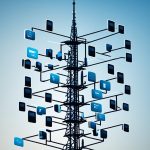Predictive maintenance has emerged as a game-changing strategy for telecom providers, enabling them to proactively address potential network issues and ensure network resilience. By leveraging data analytics and machine learning, predictive maintenance reduces network downtime by 30-70%, optimizes resource allocation, and enhances network performance. Embracing a data-driven culture, partnering with industry experts, and prioritizing critical assets are key steps in implementing effective predictive maintenance strategies.
In this article, we will explore the importance of predictive maintenance in cellular network management and discuss how it can lead to reduced network downtime, enhanced efficiency, and optimized performance. We will also delve into the practical aspects of implementing predictive maintenance strategies, such as identifying critical assets, investing in the right tools, and fostering a data-driven culture. Finally, we will highlight the future of telecom network management and the vital role that predictive maintenance plays in staying ahead in the ever-evolving telecommunications industry.
The Importance of Predictive Maintenance in Cellular Network Management
Predictive maintenance plays a crucial role in efficient cellular network management, offering a wide range of benefits. By proactively predicting equipment failures and scheduling maintenance, it significantly reduces network downtime by 30-70%. This reduction in downtime not only leads to cost savings but also enhances efficiency and improves customer satisfaction.
With predictive maintenance, operators can optimize resource allocation by scheduling maintenance based on predictive analytics, leading to increased network uptime by 20%. By addressing potential issues before they escalate, operators can prevent performance bottlenecks and ensure optimized network performance. Real-time insights from network data enable proactive interventions, allowing for a superior user experience and minimal interruptions.
In addition to performance benefits, predictive maintenance also contributes to enhanced network security. By leveraging predictive analytics, operators can detect anomalies and potential threats in real time, ensuring the integrity and security of the network.
| Benefits of Predictive Maintenance in Cellular Network Management |
|---|
| Reduced network downtime |
| Enhanced efficiency |
| Optimized performance |
By embracing predictive maintenance strategies, cellular network operators can unlock the full potential of their network infrastructure, providing reliable and uninterrupted connectivity to their customers. The implementation of predictive maintenance is a strategic step towards achieving network resilience and maintaining a competitive edge in the rapidly evolving telecommunications industry.
Note: The diagram below illustrates the impact of predictive maintenance on network downtime reduction, efficiency enhancement, and performance optimization.
Diagram: Impact of Predictive Maintenance on Cellular Network Management
Implementing Predictive Maintenance Strategies
Practical implementation is crucial for the success of predictive maintenance strategies in the telecom industry. To effectively optimize network performance and maximize impact, telecom providers should focus on:
- Identifying Critical Assets:
Telecom providers must identify the critical assets within their networks, such as core routers and cell towers. By prioritizing the monitoring and maintenance of these assets, they can ensure that potential issues are proactively addressed, reducing downtime and improving network resilience.
“Identifying critical assets is the foundation of an effective predictive maintenance strategy. By focusing resources on the most crucial components, telecom providers can significantly improve the overall performance of their networks.” – Telecom Industry Expert
- Investing in the Right Tools:
Investing in robust platforms with advanced analytics capabilities is essential for successful predictive maintenance. These tools enable telecom providers to leverage data-driven insights and tailored machine learning algorithms specific to telecom networks. By utilizing the right tools, operators can make accurate predictions, optimize maintenance schedules, and prevent potential network disruptions.
- Fostering a Data-Driven Culture:
A data-driven culture is key to implementing predictive maintenance strategies effectively. This culture encourages teams to value insights derived from data analytics and empowers them to take action based on predictive analytics. By fostering such a culture, telecom providers can ensure that the entire organization is aligned towards leveraging data to drive maintenance decisions.
- Collaboration with Technology Providers and Industry Experts:
Collaborating with technology providers and industry experts can further enhance the implementation process of predictive maintenance strategies. By leveraging external expertise, telecom providers can gain insights into industry best practices, avoid potential pitfalls, and stay at the forefront of advancements in predictive maintenance technology.

By successfully implementing these strategies, telecom providers can revolutionize their network maintenance practices, optimize network performance, and ensure a superior user experience for their customers.
The Future of Telecom Network Management
Predictive maintenance is not just a trend; it is the future of telecom network management. As networks become increasingly complex and data-driven, having a proactive approach to maintenance is crucial for ensuring seamless connectivity and maintaining a competitive edge. With the continuous advancement of technology and the growing reliance on telecommunications, telecom providers need to embrace predictive maintenance strategies to stay ahead of the curve. By leveraging the power of data analytics and machine learning, telecom providers can revolutionize their network management practices and meet the demands of the hyper-connected world.
In today’s digital landscape, where network downtime could lead to significant financial losses and customer dissatisfaction, proactive maintenance is a game-changer. By leveraging predictive maintenance techniques, telecom providers can identify potential network issues in advance and take proactive measures to prevent them from escalating into major disruptions.
Complex networks require sophisticated maintenance strategies. In the past, reactive approaches were the norm, where telecom providers would only act after a failure occurred. However, in today’s highly competitive market, this reactive approach is no longer sufficient. Proactive maintenance allows telecom providers to gain a competitive edge by minimizing downtime, reducing operational costs, and ensuring a superior user experience.
By embracing predictive analytics and machine learning, telecom providers can harness the power of data to predict equipment failures, optimize resource allocation, and prevent performance bottlenecks. This proactive approach enables them to schedule maintenance activities in a strategic manner, avoiding network disruptions during peak usage times and reducing the impact on users.
Implementing proactive maintenance strategies requires a combination of advanced technology, skilled professionals, and a data-driven culture. Telecom providers must invest in the right tools, such as robust platforms with advanced analytics capabilities, to effectively analyze network data and generate actionable insights. Additionally, fostering a data-driven culture within the organization is crucial to ensure that predictive maintenance strategies are embraced and implemented effectively.
In conclusion, proactive maintenance is not just a luxury in the telecom industry; it is a necessity. As networks continue to evolve and become more complex, telecom providers must stay one step ahead by leveraging predictive maintenance strategies. By taking a proactive approach to network management, they can ensure seamless connectivity, optimize performance, and maintain a competitive edge in the fast-paced world of telecommunications.
Strategies for Reducing Wireless Exposures in Everyday Life
Reducing wireless exposures in everyday life is essential for minimizing potential health risks. By adopting the right strategies, individuals can mitigate the effects of wireless radiation and prioritize their well-being. Here are some effective approaches:
1. Increase the Distance
One important strategy is to increase the distance from wireless emitting sources, such as cell phones and wireless laptops. Maintaining a safe distance reduces the intensity of exposure and minimizes the potential risks associated with wireless radiation.
2. Identify and Address Sources in Your Home
It is crucial to identify the various sources of wireless radiation in your home and address them step by step. Some common sources include computers, smart speakers, Wi-Fi routers, and cordless phones. By understanding where these sources are located, you can take necessary precautions to minimize your exposure.
3. Utilize Airplane Mode and Disable Transmissions
Utilizing airplane mode and disabling Wi-Fi and Bluetooth transmissions on technology devices, especially when handing them to children, can significantly reduce wireless exposures. This simple step helps mitigate the effects of radiation and promotes a safer environment.
4. Opt for Corded Landlines
Using a corded landline phone instead of relying solely on cell phones can further minimize wireless radiation exposure. Corded phones do not emit wireless radiation, offering a safer alternative for communication.
5. Implement Various Measures to Reduce Cell Phone Radiation
Reducing overall cell phone radiation exposure is crucial. Here are some measures you can take:
- Keep your phone away from your body, especially when not in use.
- Use a hands-free device to keep the phone farther away from your head.
- Limit lengthy phone calls and opt for text messages when possible.
- Avoid sleeping with your phone near your head.
By implementing these strategies and prioritizing wireless safety, individuals can minimize potential health risks associated with excessive wireless exposures in everyday life.
| Strategy | Benefits |
|---|---|
| Increase the Distance | Reduces intensity of exposure and minimizes risks |
| Identify and Address Sources in Your Home | Minimizes exposure from various wireless devices |
| Utilize Airplane Mode and Disable Transmissions | Significantly reduces wireless exposures |
| Opt for Corded Landlines | Offers a safer alternative for communication |
| Implement Various Measures to Reduce Cell Phone Radiation | Reduces overall cell phone radiation exposure |
By adopting these strategies, individuals can effectively minimize wireless exposures in their everyday lives, promoting a healthier and safer environment.
Conclusion
In conclusion, maintaining a cellular network requires proactive strategies, such as predictive maintenance, to ensure network resilience and optimal performance. By implementing predictive maintenance strategies, telecom providers can identify critical assets, invest in the right tools, foster a data-driven culture, and collaborate with experts to enhance network management practices.
Furthermore, it is essential for individuals to prioritize wireless safety in everyday life to minimize potential health risks. This includes reducing wireless exposures by increasing the distance from wireless-emitting sources, identifying and addressing sources of wireless radiation in their homes, and using airplane mode and corded technology connections whenever possible. By taking these necessary precautions, individuals can prioritize their health and minimize potential risks associated with wireless radiation.
As technology advances and our reliance on wireless communication continues to grow, it becomes imperative to strike a balance between connectivity and safety. By emphasizing wireless safety, minimizing exposures, and prioritizing health, both telecom providers and individuals can work together to create a safer and healthier wireless environment.
FAQ
What is predictive maintenance?
Predictive maintenance is a strategy that uses data analytics and machine learning to proactively identify and address potential network issues, reducing network downtime, optimizing resource allocation, and enhancing network performance.
How does predictive maintenance benefit cellular network management?
Predictive maintenance reduces network downtime by 30-70%, leading to cost savings and improved customer satisfaction. It also allows operators to optimize resource allocation, increase network uptime by 20%, and prevent performance bottlenecks.
What are the key steps in implementing predictive maintenance strategies?
The key steps in implementing predictive maintenance strategies are identifying critical assets, such as core routers and cell towers, investing in the right tools with advanced analytics capabilities, fostering a data-driven culture, and collaborating with technology providers and industry experts.
Why is predictive maintenance the future of telecom network management?
As networks become more complex and data-driven, having a proactive approach to maintenance is crucial for ensuring seamless connectivity and maintaining a competitive edge. Predictive maintenance strategies leverage the power of data analytics and machine learning to revolutionize network management practices.
How can individuals reduce wireless exposures in everyday life?
Individuals can reduce wireless exposures by increasing the distance from wireless emitting sources, identifying and addressing sources of wireless radiation in their homes, using airplane mode and turning off Wi-Fi and Bluetooth transmissions on technology devices, and opting for corded landline connections whenever possible.
Why is wireless safety important?
Wireless safety is important for minimizing potential health risks associated with wireless radiation. By prioritizing health and taking necessary precautions, individuals can minimize their exposure and reduce potential risks.



















